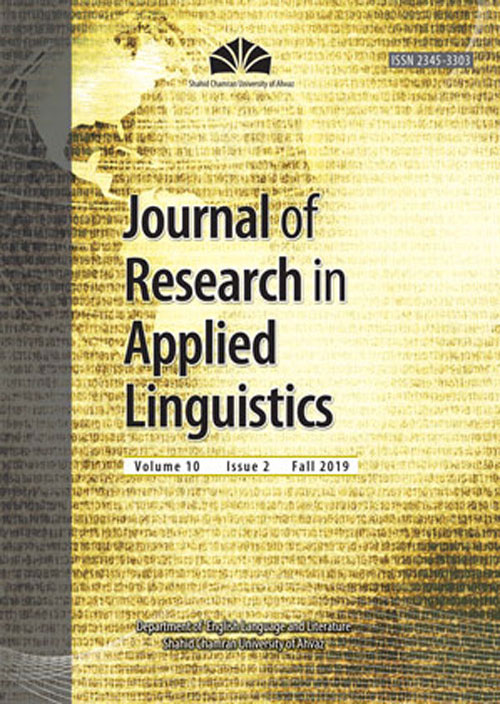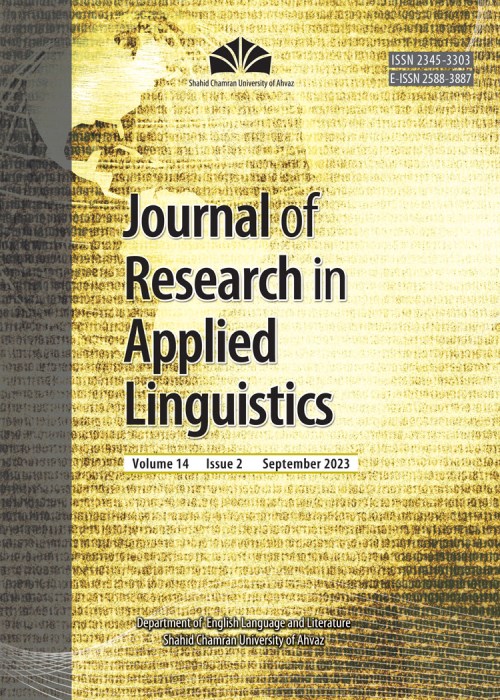فهرست مطالب

Journal of Research in Applied Linguistics
Volume:12 Issue: 2, Summer-Autumn 2021
- تاریخ انتشار: 1400/07/10
- تعداد عناوین: 7
-
-
Pages 6-21
This study investigates the use of the attitude system in engineering writing, including how attitude resources are deployed and what they target. The study analyses 10 professional engineering texts. Research suggests that professional engineering writing is largely an object-centred form of written communication, that is, focused on physical objects (Ding, 2001; McKenna, 1997). Engineering writing also has a persuasive purpose and an ‘objective’ style (Winsor, 2006), which can be challenging for novice engineering writers as it requires a command of evaluative language including an understanding of how and to what evaluation can be applied. Appraisal system offers an approach to understanding the use of evaluative language. Findings show that the valuation subtype of appreciation, a subsystem of attitude, is used in significant preference to all others. Physical objects and activities are the most commonly evaluated targets. These findings have implications for teaching writing to engineering students.
Keywords: Appraisal Analysis, Systemic Functional Linguistics (SFL), Persuasive Language, Evaluation, Engineering -
Pages 22-36A critical review is one of the text types (i.e., genres) assigned for academic writing in Australian universities; yet, the study of this genre remains underexamined in academic discourse. This qualitative study was designed to analyse the schematic structures and lexical choices in evaluative meanings within critical review texts to provide a description of the critical analysis genre that could help to familiarise students with the characteristics of the genre. Texts used for the analysis were a tutor’s model text, provided to the students in the Introductory Academic Program (IAP) at the University of Adelaide, and the critical review writing of 2 Indonesian students in the IAP class. Using both genre analysis (Martin & Rose, 2003) and the appreciation framework (Martin & White, 2005) from systemic functional linguistics (SFL), the study applied “a genre-analytic approach” (Nodoushan & Khakbaz, 2011, p.112) to analysing and describing the structure and language use of the critical review texts. Analysis of the schematic structure identified 5 stages: Introduction, Summary of the Article, Analysis of the Article: Positive Critique, Analysis of the Article: Negative Critique, and Conclusion. The values of appreciation that contributed to the evaluative purpose of the critical review genre were categorised as valuation, composition, and reaction. Based on the analysis, this report provides suggestions for structural and lexical resources for the realisation of the purpose of a critical review text and for the expression of evaluative meanings.Keywords: Genre analysis, Appraisal, Critical Review Texts, Academic writing, Systemic Functional Linguistics (SFL)
-
Pages 37-51
Children’s first years at school are critical for their language development, academic progress, and social learning. Hopefully, children make friends when they start school because friendships support children’s learning and well-being. Friendships need to be developed and maintained, and interpersonal language resources like evaluative language provide linguistic tools that contribute to this relationship work. Appraisal theory (Martin & White, 2005) provides a comprehensive framework for analyzing evaluative language. This research applies the appraisal framework to explore evaluative language in the conversations of 2 pairs of 5-to-6-year-old friends. Children in each dyad identified each other as ‘very best friends,’ and their conversations were recorded as they played together. They used appraisal resources to negotiate and build common ground, to encourage responses from their friends, and to enrich their play. This research applies Martin and White’s (2005) framework in a new context and brings a new tool to the study of children’s peer conversations.
Keywords: Appraisal theory, Young Children, Friendship, Evaluative Language, Peer Conversation, Systemic Functional Linguistics (SFL) -
Pages 52-73This paper is a contribution to appraisal-based scholarship concerned with the discursive performance of what is variously termed ‘identity’ or ‘persona’—specifically the scholarship which proposes that key aspects of textual identity/persona can be related to tendencies in speakers’i deployment of the resources for conveying evaluative meanings. Our contribution is via an analysis of similarities and differences in the use of meanings which convey attitudinal assessment by couples participating in a Chinese ‘reality TV’ family dispute resolution program; we formulate identity/persona as involving ways of presenting ‘the self,’ specifically those aspects of ‘the self’ associated with what attitudinal meanings the speaker advances and with how those meanings are advanced. We demonstrate a methodology which classifies expressions of positive/negative assessment by reference to the subtype of attitude, its valency (positive or negative), whether the assessment is explicitly or implicitly conveyed, and the type of the assessment target (who or what is being evaluated). Via this methodology, we show how these ways of self-presentation can be characterised, compared, and grouped into subtypes (i.e., ways of self-presentation which, broadly speaking, are repeated across speakers). We report findings that, in their self-presentations, the participants in this programme were broadly similar in their deployment of some options for conveying positive or negative assessment (e.g., in a preference for implicitly rather than explicitly conveying their attitude), but that there were also significant individual differences (e.g., in terms of readiness to report their own experiencing of negative emotions). Also, we offer an exploration of how computational tools for multivariate cluster analysis might be deployed to develop more abstract characterisations and comparisons of ways of self-presentation—characterisations which reference tendencies across multiple options for attitudinal assessment.Keywords: Appraisal, Textual Persona, Evaluative Language, Conflict Talk, attitude
-
Pages 74-88This study reports on the development of the interpersonal discourse semantic system of involvement based on the analysis of evaluative meanings in 3 different data sets of Chinese digitally mediated communication. It builds on prior work developed within tenor and interpersonal meanings. Within the proposed system, 3 kinds of interpersonal meaning dimensions are posited. The first relates to the relative status between interlocutors and participants within a social hierarchy and is, thus, named social hierarchy. The second relates to the positioning of the person posting and others in relation to how close their relationship is and is, thus, named social distance. The third relates to who is being positioned within the other 2 dimensions and is called involvement type. Within the 3 data sets of digitally mediated Chinese communication (i.e., forum posts, SMS, and chat room messages), we found that the Chinese interlocutors frequently positioned themselves and others in relationships both within a social hierarchy as well as in relationships concerning their relative social distance. Results show there are a number of linguistic realisations of these 3 involvement systems which Chinese interlocutors use to negotiate their relative social positions in digitally mediated communication.Keywords: Involvement, Appraisal, Interpersonal Meaning, Discourse Semantics, Affiliation
-
Pages 89-102This study explores the strategic use of resources for conveying attitudinal assessments by journalists when their communicative options are seriously curtailed—when there are severe social, legal, or political constraints on what they can say about powerful people and institutions. It offers, by way of a case study, an analysis of editorials published in two Pakistani English-language newspapers the day after the US forces covertly entered Pakistan and killed Osama bin Laden. Whereas these actions raised serious questions about the prior conduct of the Pakistani military and intelligence services, the journalists were prevented by strict legal prohibitions from any overt criticism. Through an appraisal-framework analysis, this study describes the ‘oblique’ attitudinal style used in the two editorials to advance cases which position readers to view those involved in an extremely negative light.Keywords: Appraisal, attitude, Commentary, Censorship, Journalism


